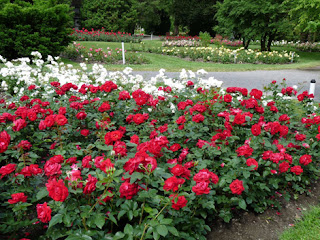Wintering Roses in Colder Climates
Not all roses need winter protection. Rugosas and their hybrids, ‘The Fairy’, the Meidiland Shrub Roses, the Canadian Explorer series roses, as well as the Redleaf Rose and many of the older roses are rock hardy and do not need any winter protection. All the modern roses (Hybrid Teas, Floribundas and Grandifloras) and all of David Austin’s English roses do. When in doubt about whether or not a particular variety needs protection, we err on the side of caution.
 STEP ONE: START FROM A POSITION OF STRENGTH:
STEP ONE: START FROM A POSITION OF STRENGTH:Roses (like all other plants) will survive the winter in much better condition if they are vigorous and healthy to begin with. Roses should be grown in full sun in a well-drained soil that has been generously amended with organic matter. The more tender varieties should be located in a spot that is sheltered from the prevailing winter winds. A balanced fertilizer should be used in spring and early summer but not after early August. Proper spring pruning and season long protection from pests and diseases are important. Regular, deep watering - right through the fall - helps immensely.
TIMING:
 |
| Construction of the new rose garden at Uncanoonuc Mt. |
Wait until the world has really cooled off before you wrap or mulch your roses. This will be long after the first few frosts. The winter protection you give your roses is not intended to keep them warm but to protect them from the rapidly fluctuating temperatures we experience over the course of a winter season. Mid-November is usually the appropriate time. Watch the weather forecasts. If a warm spell is predicted - put the job off. If substantial snow is predicted - go to it - the work will be greatly simplified.
 |
| Brand new roses all in place. |
TECHNIQUES:
There are many different approaches to protecting roses for the winter. Talk with other gardeners in your area and experiment to see what works best for you.
Burlap or Other Nursery Fabrics - First cut back any vigorous canes to a reasonable length. (We thoroughly prune our roses in the spring. This fall cut is only to make wrapping easier. By the same token, we occasionally tie together the canes of extra wide plants before wrapping.) Then wrap the plant in an overlapping cylinder, fold the top over and secure the whole thing with heavy plastic twine. Next, pile 12” of salt marsh hay around the base of the cylinder to secure it in place, seal out air and provide another measure of protection.
Rose Cones - Prune plant to fit under, weigh down to secure, mound soil or organic matter like salt marsh hay around the base of the cone. Some people cut a triangular hole in the top of the cone and pull the unpruned canes through it. They use a brick to weigh down the cone and mostly, but not completely, cover the hole. Inexpensive and easy, but the size of the cones dictates that they can only be used on smaller plants.
Salt Marsh Hay - Bury the plant under a mound of salt marsh hay 2’ deep. This simple technique has worked well for us for years.
Chicken Wire Collars - Secure a cylinder of chicken wire around the plant and fill it with loose mulching material like straw, chopped leaves or compost.
Mounding with Soil - Bury the base of the plant with at least 12” of soil or compost. Bring the material in - don’t rake it up from around the plant. An age-old technique, sometimes used in conjunction with another material; e.g.: organic matter mounded over the soil mound.
CLIMBING ROSES:
SOME OTHER APPROACHES:
For Roses on a Wall - Pegging a sheet of plywood on an angle to shield the plant.
For Roses on a Post - Wrapping in two or more layers of burlap.
For any Climber - You can (and we have) wrap climbers in protective fabric the same way you would shrub roses, first untying the canes from their supports. Once the cylinder of protective fabric has been completed, tie it back onto the supports. This prevents wind and snow from toppling the wrapped plant and breaking its canes. Use salt marsh hay at the base of climbers in the same way you would shrub roses.
Note: Cutting back vigorous canes a foot or two can lessen the amount of whipping about by winter winds which might loosen any mounds of mulch used. Tying the canes together before mulching also serves this purpose. Some people recommend defoliating (removing all the leaves) and using a protective fungicidal spray before covering. Others swear by the effectiveness of an anti-transpirant spray like Wilt-pruf.
Don’t be scared off! Over the twenty-plus years of growing roses here, I’ve made every mistake possible in wintering - covering too early, covering too late, secured inadequately - you name it. Some years they’ve suffered more severe die-back than others, but outright losses have been minimal. Most roses will come back even if the canes are killed back to the crown.
To learn more about Uncanoonuc Mt. Perennials, visit their website at www.uncanoonucmt.com





Thanks Nettie, now that the snow has cleared, it is time to take care of the roses. Very helpful info for us cold climate growers.
ReplyDelete